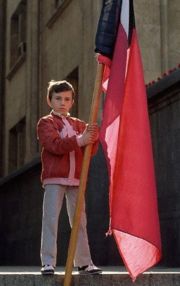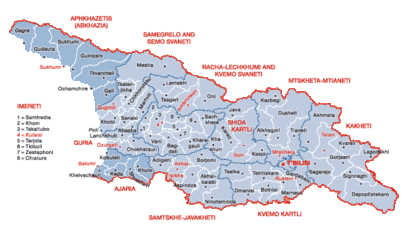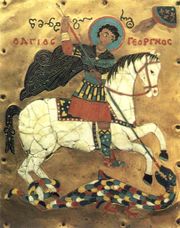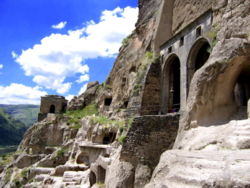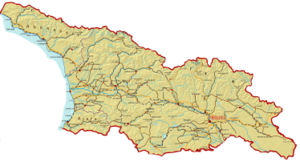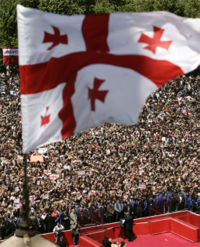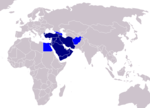Georgia (country)
2007 Schools Wikipedia Selection. Related subjects: Countries; European Countries
| საქართველო Georgia |
|||||
|
|||||
| Motto: ძალა ერთობაშია ( Georgian) "Strength is in Unity" |
|||||
| Anthem: Tavisupleba ("Freedom") | |||||
| Capital (and largest city) |
Tbilisi |
||||
| Official languages | Georgian | ||||
|---|---|---|---|---|---|
| Government | Unitary republic | ||||
| - President | Mikheil Saakashvili | ||||
| - Prime Minister | Zurab Noghaideli | ||||
| Consolidation | |||||
| - Establishment of first Georgian Kingdoms of Colchis and Iberia | c. 2000 BC | ||||
| - Establishment of unified Georgian Kingdom | 1008 AD | ||||
| - Establishment of Democratic Republic of Georgia | May 26, 1918 | ||||
| - Independence from the Soviet Union | |||||
| - Declared | March 11, 1990 | ||||
| - Recognized | September 6, 1991 | ||||
| - Completed | December 25, 1991 | ||||
| Area | |||||
| - Total | 69,700 km² ( 121st) 26,912 sq mi |
||||
| Population | |||||
| - 2005 estimate | 4,474,404 ( 117th1) | ||||
| - Density | 64/km² ( 129) 166/sq mi |
||||
| GDP ( PPP) | 2005 estimate | ||||
| - Total | $15.5 billion ( 122nd) | ||||
| - Per capita | $3,616 ( 120th) | ||||
| HDI (2003) | 0.732 (medium) ( 100th) | ||||
| Currency | Lari (ლ) ( GEL) |
||||
| Time zone | MSK ( UTC+3) | ||||
| - Summer ( DST) | MSD ( UTC+4) | ||||
| Internet TLD | .ge | ||||
| Calling code | +995 | ||||
| 1 Population figure excludes Abkhazia and South Ossetia. | |||||
Georgia ( Georgian: საქართველო, transliterated as Sakartvelo), known officially from 1990 to 1995 as the Republic of Georgia, is a country in Eurasia to the east of the Black Sea, most of which is located in the South Caucasus, while a portion of the territory lies in the North Caucasus. It shares borders with Russia in the north and Turkey, Armenia, and Azerbaijan in the south.
Georgia is a unitary, emerging liberal democratic nation-state with an ancient historical and cultural heritage. Georgian civilization stretches back for more than three thousand years of history with an exclusive literary and artistic heritage. Culturally, historically, and politically Georgia is considered part of Europe; however, the official geographic classification of the country varies according to different sources. Sometimes Georgia is considered a transcontinental nation.
The English name Georgia is a transliteration of the Hellenistic term ( Greek: Γεωργία) derived from Georgios ( Greek: Γεώργιος), a Greek name meaning "farmer"; Georgia here is indicative of a farmland. Georgians used the Greek and Aramaic alphabets before adopting the Georgian alphabet, reformed by King Pharnavaz I of Iberia, which is not directly related to any other alphabet in the world. In 337, Christianity was declared the official state religion in the ancient Georgian Kingdom of Iberia, making Georgia the second oldest country after Armenia (301) to declare Christianity its official state religion. The Bible was translated into Georgian in the 5th century.
Geographically, Georgia is diverse and its natural resources are abundant. The mixture of Alpine zone in the Caucasus mountains and the subtropical Black Sea coast of western Georgia attracts many tourists, because the country is considered both an excellent ski resort and an excellent sea resort. Georgia has one of the most ancient wine-making traditions in the world. Georgian wine is characterized as naturally semi-sweet and very competitive to French, Spanish and other Western European wines and is well known around the world, especially in Eastern Europe. Georgia has been called the birthplace of wine, due to archeological findings which indicate wine production back to 5000 B.C.
History
The recorded history of Georgia dates back more than 4,000 years.
Antiquity
Two Georgian Kingdoms of late antiquity, known to Greece and Rome as Iberia in the east of the country and Colchis in the west, were among the first nations in the region to adopt Christianity (in 337 AD, or in 319 AD as recent research suggests.). Colchis is the location of the Golden Fleece sought by Jason and the Argonauts in the Greek myth and may have derived from the local practice of using fleeces to sift gold dust from rivers. Known to its natives as Egrisi or Lazica, Colchis often saw battles between the rival power of Persia and the Byzantine Empire, both of which managed to conquer Western Georgia from time to time. As a result, those Kingdoms disintegrated into various feudal regions in the early Middle Ages. This made it easy for Arabs to conquer Georgia in the 7th century. The rebellious regions were liberated and united into the Georgian Kingdom at the beginning of the 11th century. Starting in the 12th century the rule of Georgia extended over the significant part of the Southern Caucasus, including northeastern parts and almost entire northern coast of what is now Turkey.
Medieval
Image:Geordavidjg1.jpg
The Georgian Kingdom, which was tolerant towards its Muslim and Jewish subjects (who had already been settled there for many centuries), reached its zenith in the 12th to early 13th centuries. This period has been widely termed as Georgia's Golden Age. The revival of the Georgian Kingdom was shortlived however, and the Kingdom was eventually subordinated by the Mongols in 1236. Thereafter, different local rulers fought for their independence from the central Georgian rule, until the total disintegration of the Kingdom in the 15th century. Neighbouring kingdoms exploited the situation and from the 16th century, the Persian Empire and the Ottoman Empire subordinated the eastern and western regions of Georgia, respectively.
The rulers of regions, which remained partly autonomous, organised rebellions on various occasions. Subsequent Persian and Turkish invasions further weakened local kingdoms and regions.
As a result of wars against the neighbouring countries the population of Georgia was reduced to 250 000 inhabitants at one point .
Russian subjugation
In 1783 Russia and the eastern Georgian kingdom of Kartli-Kakheti signed the Treaty of Georgievsk, according to which Kartli-Kakheti received protection by Russia. This, however, did not prevent Tbilisi from being sacked by the Persians in 1795.
On December 22, 1800 Tsar Paul I of Russia, at the alleged request of the Georgian king George XII, signed the Proclamation on the incorporation of Georgia (Kartli-Kakheti) within the Russian Empire. On January 8, 1801 Tsar Paul I of Russia, signed a decree on the incorporation of Georgia (Kartli-Kakheti) within the Russian Empire which was confirmed by Tsar Alexander I on September 12, 1801. The Georgian envoy in Saint Petersburg reacted with a note of protest that was presented to the Russian vice-chancellor Prince Kurakin. In May 1801 Russian General Carl Heinrich Knorring dethroned the Georgian heir to the throne David Batonishvili and deployed a government headed by General Ivan Petrovich Lasarev.
The Georgian nobility did not accept the decree until April 1802 when General Knorring compassed the nobility in Tbilisi's Sioni Cathedral and forced them to take an oath on the imperial crown of Russia. Those who disagreed were arrested temporarily.
In the summer of 1805 Russian troops on the river Askerani near Zagam defeated the Persian army and saved Tbilisi from conquest.
In 1810, after a brief war, the western Georgian kingdom of Imereti was annexed by Tsar Alexander I of Russia. The last Imeretian king and the last Georgian Bagrationi ruler Solomon II died in exile in 1815. From 1803 to 1878, as a result of numerous Russian wars against Turkey and Iran, several territories were annexed to Georgia. These areas ( Batumi, Artvin, Akhaltsikhe, Poti, and Abkhazia) now represent a large part of the territory of Georgia.
The principality of Guria was abolished in 1828, and that of Samegrelo (Mingrelia) in 1857. The region of Svaneti was gradually annexed in 1857– 1859.
The Soviet period
After the Russian Revolution of 1917, Georgia declared independence on May 26, 1918 in the midst of the Russian Civil War. The parliamentary election was won by the Georgian Social-Democratic Party, considered to be a party of Mensheviks, and its leader, Noe Zhordania, became the prime minister. In 1918 a Georgian-Armenian war erupted over parts of Georgian provinces populated mostly by Armenians which ended due to British intervention. In 1918-1919 Georgian general Mazniashvili led a Georgian attack against White Army led by Moiseev and Denikin in order to claim the Black Sea coastline from Tuapse to Sochi and Adler for independent Georgia. The country's independence did not last long, however. In February 1921 Georgia was attacked by the Red Army. Georgian troops lost the battle and the Social-Democrat government fled the country. On February 25, 1921 the Red Army entered the capital Tbilisi and installed a puppet communist government led by Georgian Bolshevik Filipp Makharadze. Georgia was incorporated into the Transcaucasian SFSR uniting Georgia, Armenia and Azerbaijan. The TFSSR was disaggregated into its component elements in 1936 and Georgia became the Georgian SSR.
The Georgian-born communist radical Ioseb Jughashvili was prominent among the Russian Bolsheviks, who came to power in the Russian Empire after the October Revolution in 1917. Jughashvili was better known by his nom de guerre Stalin (from the Russian word for steel: сталь). Stalin was to rise to the highest position of the Soviet state and to rule ruthlessly.
From 1941 to 1945, during the Second World War, almost 700,000 Georgians fought as Red Army soldiers against Nazi Germany. (A number also fought with the German army). About 350,000 Georgians died in the battlefields of the Eastern Front. Also during this period the Chechen, Ingush, Karachay and the Balkarian peoples from the Northern Caucasus, were deported to Siberia for alleged collaboration with the Nazis. With their respective autonomous republics abolished, the Georgian SSR was briefly granted some of their territory, until 1957.
The most radical expression of the progressive part of the society opposed to the Soviet system was the dissidential movement, which started in the 60s. Among the Georgian dissidents, the most prominent activist was Merab Kostava. He was arrested several times by the state security committee and served his term in Soviet jail.
The Georgian Eduard Shevardnadze, the USSR's Georgian minister for foreign affairs, was one of the main architects of the Perestroika reforms of the late 1980s. During this period, Georgia developed a vigorous multiparty system which strongly favoured independence. The country staged the first democratic, multiparty parliamentary elections in the Soviet Union on October 28, 1990. From November 1990 to March 1991, one of the leaders of the National Liberation movement, Dr. Zviad Gamsakhurdia, was the Chairman of the Supreme Council of the Republic of Georgia (the Georgian parliament).
Independence
Along their tradition, the Georgian people have been very conscious of their ethnic, linguistic and religious identity. It is therefore not surprising that, in the wake of the Gorbachevian Perestroika, the Georgian SSR was the first Soviet Republic to commence the struggle for national independence. The definite ‘no’ to Moscow's supremacy came on 9 April 1989, when a peaceful demonstration in the Georgian capital Tbilisi ended in a massacre in which several people were killed by Soviet troops. This incident launched an anti-Soviet mass movement similar to those of the Baltic republics, soon shattered, however, by the infightings of its radical and liberal wings. Before the October 1990 elections to the Georgian Parliament (Supreme Council) —the first polls in the USSR held on a formal multi-party basis—the political landscape was reshaped again. While the more radical groups boycotted the elections and convened an alternative forum (National Congress), another part of the anticommunist opposition united into the Round Table—Free Georgia (RT-FG) around the former dissidents like Merab Kostava and Zviad Gamsakhurdia. The latter won the elections by a clear margin, with 155 out of 250 parliamentary seats, whereas the ruling Communist Party (CP) received only 64 seats. All other parties failed to get over the 5%-threshold and were thus allotted only some single-member constituency seats.
On April 9, 1991, shortly before the collapse of the USSR, Georgia declared independence. On May 26, 1991 Zviad Gamsakhurdia was elected as a first President of independent Georgia. However, Gamsakhurdia was soon deposed in a bloody coup d'etat, from December 22, 1991 to January 6, 1992. The coup was instigated by part of the National Guards and a paramilitary organization called " Mkhedrioni" which allegedly was supported by Russian military units stationed in Tbilisi. The country became embroiled in a bitter civil war which lasted almost until 1995. Eduard Shevardnadze returned to Georgia in 1992 and joined the leaders of the coup — Kitovani and Ioseliani — to head a triumvirate called the “State Council”.
In 1995 Shevardnadze was officially elected as a president of Georgia, and reelected in 2000. At the same time, two regions of Georgia, Abkhazia and South Ossetia, quickly became embroiled in disputes with local separatists that led to widespread inter-ethnic violence and wars. Supported by Russia, Abkhazia and South Ossetia achieved and maintained de facto independence from Georgia. More than 250,000 Georgians were ethnically cleansed from Abkhazia by Abkhaz separatists and North Caucasians volunteers, (including Chechens) in 1992-1993. More than 25,000 Georgians were expelled from Tskhinvali as well, and many Ossetian families were forced to abandon their homes in the Borjomi region and move to Russia.
In 2003 Shevardnadze was deposed by the Rose Revolution, after Georgian opposition and international monitors asserted that the November 2 parliamentary elections were marred by fraud. The revolution was led by Mikheil Saakashvili, Zurab Zhvania and Nino Burjanadze, former members and leaders of Shavarnadze's ruling party. Mikheil Saakashvili was elected as President of Georgia in 2004. Restoring Georgia's territorial integrity, reversing the effects of ethnic cleansing and returning refugees to their home places were the main pre-election promises of Saakashvili's government.
Following the Rose Revolution, a series of reforms was launched to strengthen the country's military and economic capabilities. The new government's efforts to reassert the Georgian authority in the southwestern autonomous republic of Ajaria led to a major crisis early in 2004. Success in Ajaria encouraged Saakashvili to intensify his efforts, but without success, in the breakaway South Ossetia.
The country hosted an official visit from President George W. Bush in 2005.
Administrative subdivisions
Georgia is divided into 9 regions, 2 autonomous republics (avtonomiuri respublika), and 1 city (k'alak'i). The regions are further subdivided into 69 districts (raioni).
There are two autonomous republics, Abkhazia and Ajaria.
Currently, the status of South Ossetia, a former autonomous administrative district, also known as the Tskhinvali region, is being negotiated with the Russian-supported separatist government. Kodori Gorge is the only part of Abkhazia that remains under nominal Georgian control.
Major cities include: Batumi, Chiatura, Gagra, Gori, Kutaisi, Poti, Rustavi, Sokhumi, Tbilisi, Tkibuli, Tskaltubo, Tskhinvali.
The Districts of Georgia are: Abasha, Adigeni, Akhalgori, Akhalkalaki, Akhaltsikhe, Akhmeta, Ambrolauri, Aspindza, Baghdati, Batumi, Bolnisi, Borjomi, Chiatura, Chkhorotsku, Chokhatauri, Dedoplistskaro, Dmanisi, Dusheti, Gagra, Gali, Gori, Gudauta, Gulripshi, Gurjaani, Java, Kareli, Kaspi, Kedi, Kharagauli, Khashuri, Khelvachauri, Khobi, Khoni, Khulo, Kobuleti, Kutaisi, Kvareli, Lagodekhi, Lanchkhuti, Lentekhi, Liakhvi, Marneuli, Martvili, Mestia, Mtskheta, Ninotsminda, Ochamchire, Oni, Ozurgeti, Poti, Rustavi, Sachkhere, Sagarejo, Samtredia, Senaki, Shuakhevi, Sighnagi, Sokhumi, Stepantsminda, Telavi, Terjola, Tetritskaro, Tianeti, Tkibuli, Tsageri, Tskhinvali, Tsalenjikha, Tsalka, Tskaltubo, Vani, Zestaponi, and Zugdidi.
Origin of the name
Georgians call themselves Kartvelebi (ქართველები), their land Sakartvelo (საქართველო), and their language Kartuli (ქართული). These names are derived from a chief called Kartlos, said to be the father of all Georgians. According to the legend Kartlos was a son of Targamos, grandson of Biblical Japheth.
The foreign name Georgia, used in many languages of the world, is derived from Greek: George ( Greek: Γεωργ), a Greek name meaning a farmer and therefore Georgia ( Greek: Γεωργία) indicating a farmland.
The Eastern World knows Georgians as Gurjs via the Arabic Jurj and Persian گرجی Gurji, which indicates farming like the Greek name George. The Persian designation for the Georgians, گرجی Gurji, is also the source of Turkish Gürcü (pronounced "Gürdjü") and Russian Грузин ("Gruzin"). The name of the country is Gorjestan in Persian, Gürcistan in Turkish, and Грузия in Russian ("Gruziya").
Historically, the dominant province of Georgia was Kartli, also known as Iberia. Kartli or Iberia was the seat of Georgian government in most parts of Georgian history. The name Iberia is confusing the geographers of antiquity, because the historical relation between Caucasian Iberians and the Iberians from the Peninsula is not known.
There is also another way to spell Iberia as Iveria influenced from Armenian words for Georgia, respectively the ancient form of Virk (Վիրք) and the modern Vrastan (Վրաստան). There are also lots of legends and theories about the name of the country and most of them are not historically proven and correct. The name Georgia has been mistakenly supposed to have come from the country's patron St. George. According to others, the name may be related to the Persian word for wolf (gurg), object of an old cult by the Caucasian peoples, hence Gorjestan - land of wolves. Yet another proposed etymology relates the Persian name to a PIE word meaning 'mountainous'.
Geography
In the north, Georgia has a 723km common border with Russia, specifically with the Northern Caucasus federal district. The following Russian republics/subdivisions - from west to east - border Georgia: Krasnodar Krai, Karachay-Cherkessia, Kabardino-Balkaria, North Ossetia-Alania, Ingushetia, Chechnya, Dagestan. Georgia also shares borders with Azerbaijan (322 km.) to the south-east, Armenia (164 km.) to the south, and Turkey (252 km.) to the south-west.
Mountains are the dominant geographic feature of Georgia. The Likhi Range divides the country into eastern and western halves. Historically, the western portion of Georgia was known as Colchis while the eastern plateau was called Iberia. Due to a complex geographic setting, mountains also isolate the northern region of Svaneti from the rest of Georgia.
The Greater Caucasus Mountain Range separates Georgia from the North Caucasian Republics of Russia. The southern portion of the country is bounded by the Lesser Caucasus Mountains. The main Caucasus Range is much higher in elevation than the Lesser Caucasus Mountains, with the highest peaks rising more than 5,000 meters (16,400ft.) above sea level.
The highest mountain in Georgia is Mount Shkhara at 5,201 meters (17,059 feet), and the second highest is Mount Janga ( Jangi-Tau) at 5,051 meters (16,572 feet) above sea level. Other prominent peaks include Kazbegi ( Kazbek) at 5,047 meters (16,554 feet), Tetnuldi (4,974m./16,319ft.), Shota Rustaveli (4,960m./16,273ft.), Mt. Ushba (4,710m./15,453ft.), and Ailama (4,525m./14,842ft.). Out of the abovementioned peaks, only Kazbegi is of volcanic origin. The region between Kazbegi and Shkhara (a distance of about 200 km. along the Main Caucasus Range) is dominated by numerous glaciers. The Lesser Caucasus Mountains are made up of various, interconnected mountain ranges (largely of volcanic origin) that do not exceed 3,400 meters (approximately 11,000 feet). Prominent features of the area include the Javakheti Volcanic Plateau, numerous lakes, including Tabatskuri and Paravani, as well as mineral water and hot springs.
The Voronya Cave (aka Krubera-Voronia Cave) is the deepest known cave in the world. It is located in the Arabika Massif of the Gagra Range, in Abkhazia, Georgia, Caucasus. The height difference in the cave is 2,140 (± 9) metres. The same cave set the previous record for depth at 1,710 metres in 2001 by a Russian-Ukrainian team. In 2004 the penetrated depth was increased on each of three expeditions. At that point the Ukrainian team crossed the -2000 m mark for the first time in the history of speleology. In October 2005, a new, unexplored part was found by CAVEX team, and the cave became even deeper. This expedition confirmed the depth of the cave which is now - 2,140 (± 9) metres deep.
Major rivers in Georgia include the Rioni and the Mtkvari.
Main cities:
- Tbilisi 1,066,100 (metro area 1,270,800)
- Kutaisi 183,300
- Batumi 116,900
Landscape
The landscape within the nation's boundaries is quite varied. Western Georgia's landscape ranges from low-land marsh-forests, swamps, and temperate rain forests to eternal snows and glaciers, while the eastern part of the country even contains a small segment of semi-arid plains characteristic of Central Asia. Forests cover around 40% of Georgia's territory while the alpine/ subalpine zone accounts for roughly around 10% of the land.
Much of the natural habitat in the low-lying areas of Western Georgia has disappeared over the last 100 years due to the agricultural development of the land and urbanization. The large majority of the forests that covered the Colchis plain are now virtually non-existent with the exception of the regions that are included in the national parks and reserves (i.e. Paleostomi Lake area). At present, the forest cover generally remains outside of the low-lying areas and is mainly located along the foothills and the mountains. Western Georgia's forests consist mainly of deciduous trees below 600 meters (1,968 ft.) above sea level and comprise of species such as oak, hornbeam, beech, elm, ash, and chestnut. Evergreen species such as box may also be found in many areas. There are significant concentrations of endemic species of plants as well. The west-central slopes of the Meskheti Range in Ajaria as well as several regions in Samegrelo and Abkhazia are covered by temperate rain forests. Between 600-1,500 meters (1,968-4,920 ft.) above sea level, the deciduous forest becomes mixed with both broad-leaf and coniferous species making up the plant life. The zone is made up mainly of beech, spruce, and fir forests. From 1,500-1,800 meters (4,920-5,904 ft.), the forest becomes largely coniferous. The tree line generally ends at around 1,800 meters (5,904 ft.) and the alpine zone takes over, which in most areas, extends up to an elevation of 3,000 meters (9,840 ft.) above sea level. The eternal snow and glacier zone lies above the 3,000 meter line.
Eastern Georgia's landscape (referring to the territory east of the Likhi Range) is considerably different from that of the west. Although, much like the Colchis plain in the west, nearly all of the low-lying areas of eastern Georgia including the Mtkvari and Alazani River plains have been deforested for agricultural purposes. In addition, due to the region's relatively drier climate, some of the low-lying plains (especially in Kartli and south-eastern Kakheti) were never covered by forests in the first place. The general landscape of eastern Georgia comprises numerous valleys and gorges that are separated by mountains. In contrast with western Georgia, nearly 85% of the forests of the region are deciduous. Coniferous forests only dominate in the Borjomi Gorge and in the extreme western areas. Out of the deciduous species of trees, beech, oak, and hornbeam dominate. Other deciduous species include several varieties of maple, aspen, ash, and hazelnut. In the upper Alazani River Valley, there are yew forests as well. At higher elevations above 1,000 meters (3,280 ft.) above sea level (particularly in the Tusheti, Khevsureti, and Khevi regions), pine and birch forests dominate. In general, the forests in eastern Georgia occur between 500-2,000 (1,640-6,560 ft.) meters above sea level, with the alpine zone extending from 2,000/2,200-3,000/3,500 meters (roughly about 6,560-11,480 ft.). The only remaining large, low-land forests remain in the Alazani Valley of Kakheti. The eternal snow and glacier zone lies above the 3,500 metre (11,480 ft.) line in most areas of eastern Georgia.
Climate
The climate of Georgia is extremely diverse, considering the nation's small size. There are two main climatic zones, roughly separating Eastern and Western parts of the country. The Greater Caucasus Mountain Range plays an important role in moderating Georgia's climate and protects the nation from the penetration of colder air masses from the north. The Lesser Caucasus Mountains partially protect the region from the influence of dry and hot air masses from the south as well.
Much of western Georgia lies within the humid subtropical zone with annual precipitation ranging from 1000-4000mm. (39-157 inches). The precipitation tends to be uniformly distributed throughout the year, although the rainfall can be particularly heavy during the Autumn months. The climate of the region varies significantly with elevation and while much of the lowland areas of western Georgia are relatively warm throughout the year, the foothills and mountainous areas (including both the Greater and Lesser Caucasus Mountains) experience cool, wet summers and snowy winters (snow cover often exceeds 2 meters in many regions). Ajaria is the wettest region of the Caucasus, where the Mt. Mtirala rainforest, east of Kobuleti receives around 4500mm (177 inches) of precipitation per year.
Eastern Georgia has a transitional climate from humid subtropical to continental. The region's weather patterns are influenced both by dry, Central Asian/Caspian air masses from the east and humid, Black Sea air masses from the west. The penetration of humid air masses from the Black Sea is often blocked by several mountain ranges ( Likhi and Meskheti) that separate the eastern and western parts of the nation. Annual precipitation is considerably less than that of western Georgia and ranges from 400-1600mm. (16-63inches). The wettest periods generally occur during Spring and Autumn while Winter and the Summer months tend to be the driest. Much of eastern Georgia experiences hot summers (especially in the low-lying areas) and relatively cold winters. As in the western parts of the nation, elevation plays an important role in eastern Georgia as well, and climatic conditions above 1500 meters (4920ft.) above sea level are considerably cooler (even colder) than those of the low-lying areas. The regions that lie above 2000 meters (6560ft.) above sea level frequently experience frost even during the summer months.
Politics
Following a crisis involving allegations of ballot fraud in the 2003 parliamentary elections, Eduard Shevardnadze resigned as president on November 23, 2003 in the bloodless Rose Revolution. The interim president was the speaker of the outgoing parliament (whose replacement was annulled), Nino Burjanadze. On January 4, 2004 Mikheil Saakashvili, leader of the National Movement - Democrats (NMD) (former United National Movement) won the country's presidential election and was inaugurated on January 25. Fresh parliamentary elections were held on March 28 where NMD secured the vast majority of the seats (with ca. 75% of the votes) with only one other party reaching the 7% threshold (the Rightist Opposition with ca. 7.5%). The vote is believed to have been one of the freest ever held in independent Georgia although an upsurge of tension between the central government and the Ajarian leader Aslan Abashidze affected the elections in this region.
The tension between the Georgian government and that of Ajaria grew increasingly after the elections until late April. Climaxing on May 1 when Abashidze responded to military maneuvers held by Georgia near the region with having the three bridges connecting Ajaria and the rest of Georgia over the Choloki River blown up. On May 5, Abashidze was forced to flee Georgia as mass demonstrations in Batumi called for his resignation and Russia increased their pressure by deploying Security Council secretary Igor Ivanov.
On February 3, 2005, Prime Minister Zurab Zhvania allegedly died of carbon monoxide poisoning in an apparent gas leak at the home of Raul Usupov, deputy governor of Kvemo Kartli region. Later, Zhvania's close friend and a long-time ally, Finance Minister Zurab Nogaideli has been appointed for the post by President Saakashvili.
Since coming to power in 2003, Saakashvili has boosted spending on the country's armed forces and increased its overall size to around 26,000. Of that figure, 5,000 have been trained in advanced techniques by U.S. military instructors. Some of these troops have been stationed in Iraq as part of the international coalition in the region, serving in Baqubah and the Green Zone of Baghdad. In May 2005, the 13th Infantry Battalion ("Shavnabada") became the first full battalion to serve outside of Georgia. This unit was responsible for two checkpoints to the Green Zone, and provided security for the Iraqi Parliament. In October 2005, the unit was replaced by the 21st Infantry Battalion. Soldiers of the 13th battalion wear the "combat patches" of the American unit they served under, the Third Infantry Division. The Georgian government claims to have restored “constitutional order” in the upper Kodori Gorge — the sole Georgia-controlled part of breakaway region Abkhazia.
Political relations
Georgia maintains good relations with its direct neighbours Armenia, Azerbaijan and Turkey and participates actively in regional cooperation fora such as the Black Sea Economic Council and the GUAM Grouping. Georgia maintains very close and warm relations with Ukraine. During the Orange Revolution in Kiev, thousands of Georgians rallied in support of Viktor Yushchenko in Ukraine, Tbilisi and in North America.
Relations with NATO
Georgia is working in becoming a full member of NATO. In August of 2004, the Individual Partnership Action Plan of Georgia was submitted officially to NATO. On October 29, 2004, the North Atlantic Council of NATO approved the Individual Partnership Action Plan (IPAP) of Georgia under the silence procedure and Georgia moved on to the so-called second stage of Euro-Atlantic integration. In 2005, by the decision of the President of Georgia, a state commission was set up to implement the Individual Partnership Action Plan, which presents an interdepartmental group headed by the Prime Minister. The Commission was tasked with coordinating and controlling the implementation of the Individual Partnership Action Plan.
On February 14, 2005, the agreement on the appointment of Partnership for Peace (PfP) liaison officer between Georgia and the North Atlantic Treaty Organization came into force, whereby a liaison officer for the South Caucasus was assigned to Georgia. On March 2, 2005, the agreement was signed on the provision of the host nation support to and transit of NATO forces and NATO personnel. On March 6-9, 2006, the IPAP implementation interim assessment team arrived in Tbilisi. On April 13, 2006, the discussion of the assessment report on implementation of the Individual Partnership Action Plan was held at NATO Headquarters, within 26+1 format.
Relations with European Union
President Saakashvili views membership of the EU and NATO as a long term priority. As he does not want Georgia to become an arena of Russia-US confrontation he seeks to maintain close relations with the United States, at the same time underlining his ambitions to advance co-operation with Russia.
The European Union is deeply concerned about continuing tension between Georgia and Russia and recent incidents in South Ossetia, which do not contribute to stability and freedom of movement. The European Union is particularly worried by the recent closure of the only recognized border crossing between Georgia and the Russian Federation. The European Union emphasises the importance of ensuring freedom of movement of goods and people, in particular by keeping the border crossing at Zemo Larsi open.
On October 2, 2006, signed a joint statement on the agreed text of the Georgia-European Union Action Plan within the European Neighbourhood Policy (ENP). The Action Plan will be formally approved at the EU-Georgia Cooperation Council session which is planned for November 14 in Brussels.
Relations with the United States
The growing US influence in Georgia, notably through the Train and Equip military assistance programme and the construction of the Baku-Tbilisi-Ceyhan pipeline, have made Tbilisi’s relations with Moscow frequently strained. The US has announced that the programme will come to an end in the early summer of 2004 and will be replaced by more regular military support activities. Former US Secretary of State Colin Powell has announced that it is not the intention of the US to establish military bases in Georgia.
“We call on the Government of Georgia and the Abkhaz authorities to abide by the 1994 ceasefire agreement and all relevant agreements pertaining to Georgia's Abkhazia region. The United States supports demilitarizing the Kodori Valley... We urge the two parties to return promptly to the Coordination Council to resume discussions of a peaceful end to the conflict,” according to a US statement.
Relations with Russia
- see: Georgian-Russian relations
Economy
Historically, Georgian economy was based on agriculture and tourism. Many ancient civilizations have gone through Georgia and enriched and sometimes destroyed the country economically. In 20th century, Georgian economy belonged to the Soviet Socialist planned regime. Since 1991, Georgia has undergone many changes while transporting the nation into the capitalist, free market economy. According to the recent statistics, total imports exceed the amount of total exports and the GDP slightly decreased as a result of government investments. However, according to the World Bank, Georgia is considered as the number one economic reformer in the world as it has in one year dropped from place 112 to place 37 in term of ease of doing business, when most of the country's neighbours' are in the 100s of the World Bank rank.
Georgia's economy has traditionally revolved around Black Sea tourism, cultivation of citrus fruits, tea and grapes; mining of manganese and copper; and output of a small industrial sector producing wine, metals, machinery, chemicals, and textiles. The country imports the bulk of its energy needs, including natural gas and oil products. Its only sizable internal energy resource is hydropower. Despite the severe damage the economy has suffered due to civil strife, since 1995, GDP has grown and inflation been lowered. The Georgian economy continues to experience large budget deficits due to a failure to collect tax revenues. The country's economic growth has also been greatly damaged by widespread corruption. Transparency International, an internationally recognised and widely respected organisation committed to highlighting and fighting corruption worldwide, places Georgia at joint number 99th in the world in its 2006 Corruption Perceptions Index (with number 1 being considered the least corrupt nation)(see www.transparency.org/policy_research/surveys_indices/cpi/2006). This, however, is a significant improvement on the 2005 Corruption Perceptions Index when Georgia was rated joint 130th. Georgia also still suffers from energy shortages; it privatized the distribution network in 1998, and deliveries are steadily improving. Georgia is pinning its hopes for long-term recovery on the development of an international transportation corridor through the key Black Sea ports of P'ot'i and Batumi.
Demographics
Georgia's current population is 4,661,473 (July 2006 est.) , with ethnic Georgians forming a majority of about 83.8%. Azerbaijanis form 6.5% of the population, Armenians 5.7% and Russians 1.5% (most Russians have emigrated since Georgia declared its independence). The Abkhazians in Abkhazia and the Ossetians in South Ossetia (and across the border in North Ossetia) have tried to secede from Georgia since independence. Two other Kartvelian groups live in Georgia: the Svan and the Mingrelians, with smaller numbers of the Laz people, most of whom live in Turkey. They are linguistically different but closely related ethnically and culturally to other Georgians. There are numerous smaller groups in the country, including Assyrians, Chechens, Greeks, Kabardins, Kurds, Jews, Tatars, Turks and Ukrainians.
Since the fall of the Soviet Union, Georgia has suffered a serious population collapse as the rebellion in Abkhazia, the strife in Ajaria and South Ossetia, a fragile economy, and bad job opportunities led hundreds of thousands of Georgians to emigrate in search of work, especially to Russia. That problem is exacerbated by a very low birthrate among the remaining population. A similar problem exists in neighboring Armenia. The population is currently estimated to be a full million less than it was back in 1990, and some observers suggest the actual number is even lower. A side effect of this emigration is that the ethnic minority proportion of the population has roughly halved in the last fifteen years, as minority groups are more likely to leave the country.
Religion
Today most of the population practices Orthodox Christianity of the Georgian Orthodox Church (83.9%). Georgia is the second oldest country after Armenia to declare Christianity as an official state religion of Kartli (Iberia) in 327. However, Christian communities already existed in Egrisi (modern day Abkhazia) before St. Nino preached Christianity. In addition, Christ's Appostles, Simon and Andrew preached Christianity in Georgia and this makes Georgian Orthodox Church Apostolic and it is mostly referred as Georgian Orthodox and Apostolic Church. Georgian Orthodox Church gained its autocephaly in the 5th century during the reign of Vakhtang Gorgasali. The Bible was also translated in Georgian in the 5th century.
The religious minorities are: Muslim (9.9%); Armenian Apostolic (3.9%); Roman Catholic (0.8%). 0.8% of those recorded in the 2002 census declared themselves to be adherents of other religions and 0.7% declared no religion at all .
Gallery of Georgia
|
Ananuri Church |
Keselo Towers, Tusheti |
Mestia, Svaneti |
|
|
Tbilisi at night |
Ananuri Church |
||
|
Sameba Church Gergeti, Kazbegi |
River Rioni in Imeretia |
Svaneti |
Svan Towers |
|
Tusheti |
|||
Culture
See also Georgian language, Georgian alphabet, Music of Georgia, Public holidays in Georgia
Education
Universities in Tbilisi include:
- Tbilisi State University
- Tbilisi State Medical University
- Georgian Agrarian University
- Georgian Technical University
- Tbilisi State Pedagogical University
- Tbilisi State University of Languages and Culture
- International Black Sea University
- Georgian University of Social Sciences
Neighbouring countries
 |
Black Sea |
 |
||
Albania · Andorra · Armenia1 · Austria · Azerbaijan2 · Belarus · Belgium · Bosnia and Herzegovina · Bulgaria · Croatia · Cyprus1 · Czech Republic · Denmark · Estonia · Finland · France · Georgia2 · Germany · Greece · Hungary · Iceland · Ireland · Italy · Kazakhstan2 · Latvia · Liechtenstein · Lithuania · Luxembourg · Republic of Macedonia · Malta · Moldova · Monaco · Montenegro · Netherlands · Norway · Poland · Portugal · Romania · Russia2 · San Marino · Serbia · Slovakia · Slovenia · Spain · Sweden · Switzerland · Turkey2 · Ukraine · United Kingdom · Vatican City
(1) Entirely in Asia but having socio-political connections with Europe. (2) Has significant territory in Asia.
Afghanistan • Armenia • Azerbaijan 1 • Bahrain • Bangladesh • Bhutan • Brunei • Cambodia • People's Republic of China 2 • Cyprus • East Timor 3 • Georgia 1 • India • Indonesia 3 • Iran • Iraq • Israel • Japan • Jordan • Kazakhstan 1 • Kuwait • Kyrgyzstan • Laos • Lebanon • Malaysia • Maldives • Mongolia • Myanmar • Nepal • North Korea • Oman • Pakistan • Philippines • Qatar • Russia 1 • Saudi Arabia • Singapore • South Korea • Sri Lanka • Syria • Tajikistan • Thailand • Turkey 1 • Turkmenistan • United Arab Emirates • Uzbekistan • Vietnam • Yemen
For dependent and other territories, see Dependent territory and List of unrecognized countries.
1 Partly in Europe. 2 The Republic of China (Taiwan) not officially recognized by the United Nations; see Political status of Taiwan. 3 Partly or wholly reckoned in Oceania.
|
Afghanistan1 • Armenia • Azerbaijan1 • Bahrain • Cyprus • Georgia1 • Iran • Iraq • Israel • Jordan • Kuwait • Lebanon • Oman • Qatar • Saudi Arabia • Syria • Turkey1 • United Arab Emirates • Yemen |
Armenia • Azerbaijan • Belarus • Georgia • Kazakhstan • Kyrgyzstan • Moldova • Russia • Tajikistan • Ukraine • Uzbekistan
Associate Member: Turkmenistan
Observers: Armenia • Austria • Croatia • Czech Republic • Georgia • Hungary • Lithuania • Mozambique • Poland • Serbia • Slovakia • Slovenia • Ukraine





